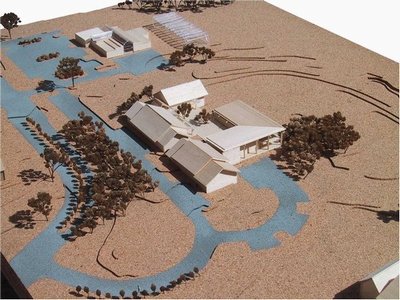September 30, 2003
Center for Urban Horticulture begins rebuilding Merrill Hall
The remaining shell of Merrill Hall is coming down and construction fencing is going up at the Center for Urban Horticulture. A groundbreaking ceremony tomorrow will mark the start of construction to replace the building, which was fire bombed May 2001 by domestic terrorists. Construction is expected to take 11 months.
“The state, University of Washington and donors came together during extraordinarily stressful times, including the current economic downturn, to get money for the center when it was needed and now the project is a reality,” said Tom Hinckley, professor of forest resources and director of the center. For example, after bids opened in August came in higher then expected, the University of Washington made arrangements for another $800,000 for the project.
The $7.2 million for design and construction includes money from the UW and state, as well as about $1 million in donations.
“Within hours of the fire we were getting calls from people wanting to donate,” Hinckley said.
When rebuilt, Merrill Hall will be slightly larger with 20,000 square feet of space compared to the previous 17,000 square feet. Its footprint will be similar, with the one end being extended to the north onto a lawn area creating space for the Miller Library.
With money from the UW and donations, the new building will have an expanded lobby, referred to as the commons, that should make it easier for visitors to find their way around the center as well as being a place to showcase information about plants, gardens and forest and urban resources. Donations mean the library will have 20 percent more space and the center will have a system to collect and reuse water from the roofs of all the buildings that surround the courtyard, one of several building features to promote sustainable use of natural resources.
Miller Hull Partnership of Seattle designed the building and CDK Construction Services of Duvall is building it. Along with the library, Merrill Hall will have offices for outreach and education, the Washington State University-King County Cooperative Extension Service’s Master Gardener program and foundation, an herbarium with plant samples, and faculty offices and laboratories.
Members of the domestic terrorist group Earth Liberation Front claimed responsibility for the firebombing in 2001. The group targeted the office of research associate professor Toby Bradshaw incorrectly believing that Bradshaw was genetically engineering poplar trees at the center. Even if he was, U.S law says it is allowable to use transgenic trees for research. Bradshaw says genetically engineered poplar trees are useful for understanding tree genetics, an opinion about a lawful activity that got him on the group’s hate list.
In spite of the arson attack, the new building has not been planned as a bunker, Hinckley said. While the building incorporates the latest fire-prevention technology and a security system, the building itself has been planned so it is even more open to the students, neighbors and the horticulture community.
The Center for Urban Horticulture, a part of the College of Forest Resources, conducts work on such things as preserving Washington’s endangered plants, finding ways to re-establish native grasses and plants in the region’s prairies where invasive non-natives now reign, rehabilitating wetlands and natural areas in our cities, and helping home gardeners and landscape professionals.
###
For more information:
Hinckely, 206-543-1588, hinckley@u.washington.edu
Image: http://www.washington.edu/newsroom/news/images/building3D.jpg
–This architectural model shows the courtyard at the Center for Urban Horticulture, the rebuilt Merrill Hall in the foreground and the two smaller, existing halls that escaped being burned in the fire. Although it looks as if Merrill Hall is composed of two buildings, one L-shaped and other rectangular, it is all one structure. The rectangular portion will house the library.
Image http://www.washington.edu/newsroom/news/2002archive/07-02archive/k070102.html
— The commons planned at the Center for Urban Horticulture will include an expanded information desk and a new entrance to the library and herbarium.

